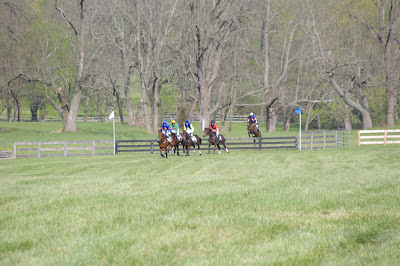I must say, the Grand National is one of my favorite races. For the money, a general admission pass will give you three great races viewed from a hillside, and don't forget your picnic basket and waterproof picnic blanket. This is a hard value to beat when it comes to racing and the view of the course.
2012 Grand National
The Grand National began in 1898 when several young men who wanted to compete in the Maryland Hunt Cup, but were too young to enter, established this race. All the riders were under 16 and rode ponies, except for one horse. The race was run over 2 1/2 miles near Chattolanee Hotel near the Golf Course of the present Green Spring Valley Club. As the riders became older, the age limit was raised so they could continue to participate.
The race continued to be run over various courses in the Green Spring Valley through 1917, with the lengthening to 3 miles in 1906 and averaging 15 to 20 fences plus ditches and even streams.
With a brief hiatus due to World War I, the race resumed in 1920 at Five Farms, the estate of Stuart Oliver, until the property was sold in Baltimore Country Club for their new golf course.
In 1925 the Grand National moved to Brooklandwood, the estate of Captain Isaac Emerson, now the site of St. Paul's School at the corner of Falls Road and Green Spring Valley Road, where it remained through 1934. This 3 mile course consisted of 15 fences averaging 4'1" high and also had a water jump. It was in 1934 the for the first time a second race was added to the card for the Grand National, the Churchville Cup which was run from 1934 until1939.
2012 Grand National
Another move was in store for the race, this time to Hereford Farms, the William R. Wittingham estate at the corner of York road and Piney Hill Road, just south of Hereford, where the race was run from 1935 until 1942, when World War II again interrupted racing. The Hereford Farms course was 1 1/2 miles long run twice around and had 16 fences to be negotiated. It was also here that the first subscriber fee was introduced to watch the races. In 1940, the Foxhunter's Challenge Cup was added to the days card, as a replacement for the Churchville Cup, and was run by members of recognized hunts or United States Army officers over a five mile course.
With the war over, the Grand National was once again resumed in 1946, this time in its final and current location, Western Run Valley and the farms of the Griswold and Fenwick families. The 3 mile course consisted of 18 fences, 2 board and 16 rail, ranging from 3'9" to 4'2" high.
In 1949 the Western Run Plate was added to the card and then in 1965 the Benjamin H. Murray Memorial was added, giving the day the three races it retains to this day. As a side note, the current Western Run Plate is a revival of that original race begun in 1949.
While the Grand National is often compared to the Maryland Hunt Cup, there are distinct differences, the Grand National is a shorter race, resulting in faster racing. The Hunt Cup is the real test of a horses endurance.
So this Saturday, like every second to last Saturday in April, I make the trek to Western Run Valley to join my friends and many strangers to watch some amazing athletes, both horses and jockeys, compete in one of the most exciting sports, in some of the most beautiful settings. I wouldn't have it any other way!
All Rights Reserved.


No comments:
Post a Comment